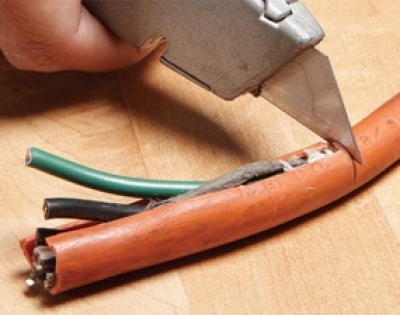How to Repair Power Cords Quickly and Safely
Identify the Source of the Problem
The first step is to locate where the cord is failing. In some cases it will be near the end where the connectors are attached. In other cases, you will notice a gash or hole through the insulation that can indicate where one of the wires has frayed or detached. As long as you can identify where the problem lies, then chances are that it can be fixed.
Fixing Ends
If the cord is sound and the problem lies near where it meets one of its connectors, then you simply need to replace the connector. Cut the wire at a location at least a couple of inches behind the connector. Remove some of the insulation from the end so the internal wires are exposed. For two prong extension cords, there will be two distinct wires, one that connects to each prong. For three pronged wires, there will be three wires.
In most cases, each wire in the cord will be color coded, which makes it easy to distinguish where they connect to the plug. In some cords, the wires will have different patterns or numbers printed on their insulation that will help you to match them up properly as well. In any case, it is crucial that you match the ends of the wires properly in order to avoid creating a hazard. Look at the old connector, match the colors with the wires in the cord and then compare them to the colors in the new connector.
Remove the insulation from the wires in the cords and attach them to their respective ends in the connector. How they are attached will depend on the design of the connector or plug that you are using. Some will have tubes that you can insert the wires into and then crimp them together whereas others have little eye-holes that you can feed and wrap the wire around. Make sure that the connections are secure and insulated before making the final attachment and testing the cord.
Fixing Center Problems
The only way to repair a cord that is damaged in the center is to expose the outer insulation and visualize the problem with the wires inside. You will most likely need to cut the cord and expose the damaged wires before splicing them with a new section of cord. Then you can attach the new section to the other part of the cord and everything should work fine. You can either cut away a section of the cord you are using to make the splice, or you can use wire from somewhere else. If you use wire from a different source, make sure that it is the same guage in order to ensure continuity along the cord.

Simply attach the new “bridge” to the respective wires and insulate the connections. You can find some accessories online or in stores that can be used as a “sheath” for some cords as well. However, you can simply cover the cut areas of the cord with some electrical tape and secure with duct tape on top as well. This may look messy, but it will get the job done. Just keep in mind that this improvisation will not be as water-resistant as using proper insulation.
Hot Ends
Some plugs get warm or hot, and this can either be caused by a fault in the connector itself or the outlet in the wall. Warmth is generally indicative of corrosion, oxidation or other problems that occur over time. If replacing the plug or repairing the cord does not correct this problem, chances are that the source of heat generation is in the outlet, and this can indicate that it needs to be cleaned, repaired or replaced.

This general illustration can help you to restore your power cords, and attempting a fix is definitely worth the effort as they can be as good as new once you are finished. Try it out for yourself and see if this trick will help you to extend the life of old cords so you can avoid hunting or purchasing new ones.
